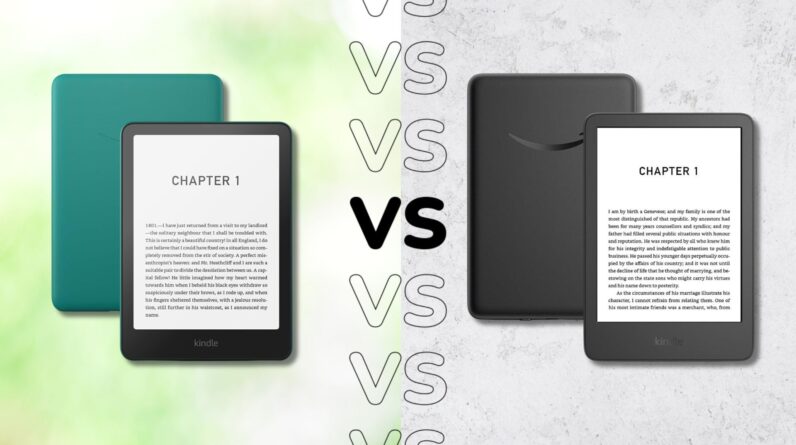
Amazon has announced an update to its popular Kindle collection for 2024, including a new Kindle and a new Kindle Paperwhite – but what’s the difference between the two?
While there was once a time when the Paperwhite was an all-round upgrade on the regular Kindle, the playing field has been levelled in recent years.
The Kindle Paperwhite still offers a larger, white E Ink screen and additional benefits like longer battery life, but core elements, like a 300ppi pixel density and the inclusion of a backlit screen, are consistent among the two.
We’re yet to go hands-on with the latest Kindle or Kindle Paperwhite, so here’s how the two compare on paper for now. We’ll update this in the coming weeks with a definitive verdict once we’ve thoroughly used both e-readers.
Pricing & availability
The Kindle (2024) is comfortably more affordable than its premium sibling, starting at £94.99/$94.99 for a version with ads, or £10/$10 more without any ads. It’s available to pre-order via Amazon right now ahead of release on 31 October 2024.
The Kindle Paperwhite (2024), on the other hand, starts at £159.99/$159.99 with ads, and much like the regular Kindle, it’s an additional £10/$10 if you want an ad-free version. It too is available to pre-order now ahead of release on 31 October 2024.
The Kindle (2024) is more portable
The Kindle Paperwhite may have a slightly larger 7-inch canvas compared to the regular Kindle’s 6-inch alternative, but that means that the latter is way more portable with a smaller screen that’ll easily fit into most bags and possibly even some pockets.
It’s not just because it has a slightly smaller footprint either; at 158g, it’s also 53g lighter than the 211g Kindle Paperwhite.
That said, the Kindle Paperweight is a smidge thinner than the Kindle, measuring in at 7.8mm and 8mm respectively, though we double that’d be a big enough difference to have much of a knock-on effect in day-to-day use.


The Kindle Paperwhite (2024) has more advanced display tech
As hinted at by the name, the big difference between the Kindle Paperwhite and the regular Kindle is the display tech. While the standard Kindle uses a greyscale E Ink screen, the Kindle Paperwhite has a white E Ink screen, with the latter bringing the reading experience even closer to its real-world equivalent.
As well as a brilliantly white screen for reading Kindle books, it also comes with additional benefits like a warm reading mode that’s designed for late-night reading, reducing the blue light generated by the backlight. It’s certainly a little more natural and easier on the eyes than the regular Kindle’s greyscale alternative, judging by previous iterations of Kindle Paperwhite.
However, unlike early versions of the Kindle and Kindle Paperwhite, the two now share a bunch of the same technologies including the same 300ppi pixel density, 16GB of storage and even a built-in front light for night-time reading. Even the latest updates, like a 25% brighter screen and faster page-turning, are shared among the two e-readers.
It really does boil down to the E Ink screen tech – and a couple of other unrelated features we’ll come to shortly.
The Kindle Paperwhite (2024) has better battery life
With a larger 7-inch screen leading to a larger chassis, the Kindle Paperwhite can squeeze in a larger battery than the 6-inch Kindle. That means that, even with a slightly larger screen to power, the Kindle Paperwhite can last up to 12 weeks on a single charge.
The standard Kindle, on the other hand, has up to six weeks of battery on a single charge. That’s not an insignificant difference between the two, essentially meaning you’ll have to charge the regular Kindle twice for every single charge of the Kindle Paperwhite – though both will easily outlast regular tech like tablets.
If you find you often reach for your e-reader only to find that its battery is completely flat, the boosted battery life of the Paperwhite might well appeal to you.


The Kindle Paperwhite (2024) is waterproof
Lastly, the Kindle Paperwhite offers IPX8 water resistance which means that, in addition to surviving a few splashes, can actually survive being submerged in up to 1.5m of water for up to half an hour.
It’s unlikely that anyone will intentionally take their Kindle Paperwhite for a swim, but it does provide added peace of mind for those who like to read at the beach or by a pool.
The regular Kindle, for comparison, offers no kind of water resistance at all, leaving it vulnerable to even slight splashes of water.
Early Verdict
The core Kindle experience – being able to download thousands of books from the Kindle store for on-the-go reading – is consistent among the two. It’s the additional features, like choosing between a white and greyscale E Ink screen, and water resistance, that’ll sway your buying decision one way or the other.
The Kindle Paperwhite looks to be the more capable of the two, with its paperwhite E Ink screen, longer battery life, larger screen and water resistance, but it’s also comfortably more expensive than the regular Kindle.
Whether these additional features are worth it will likely depend on your specific scenario, but we’ll reserve our final thoughts for once we’ve thoroughly tested both of Amazon’s latest Kindles.






